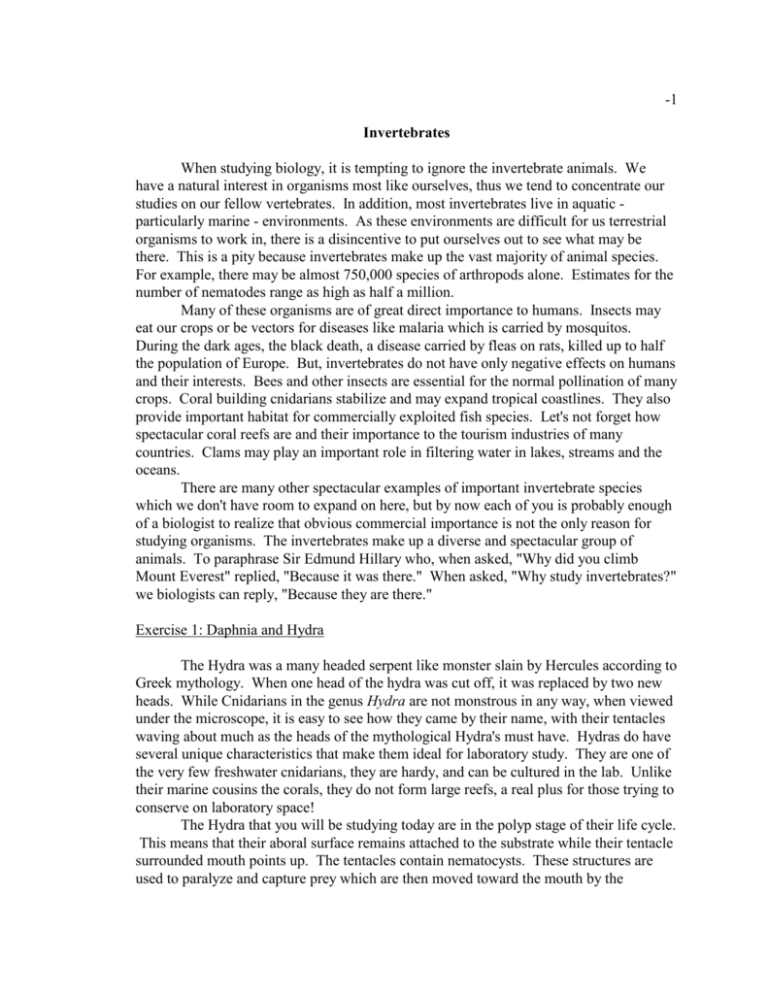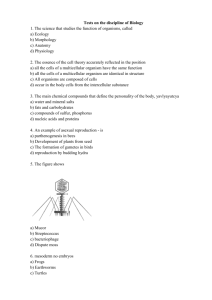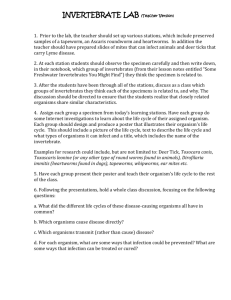Invertebrates
advertisement

-1 Invertebrates When studying biology, it is tempting to ignore the invertebrate animals. We have a natural interest in organisms most like ourselves, thus we tend to concentrate our studies on our fellow vertebrates. In addition, most invertebrates live in aquatic particularly marine - environments. As these environments are difficult for us terrestrial organisms to work in, there is a disincentive to put ourselves out to see what may be there. This is a pity because invertebrates make up the vast majority of animal species. For example, there may be almost 750,000 species of arthropods alone. Estimates for the number of nematodes range as high as half a million. Many of these organisms are of great direct importance to humans. Insects may eat our crops or be vectors for diseases like malaria which is carried by mosquitos. During the dark ages, the black death, a disease carried by fleas on rats, killed up to half the population of Europe. But, invertebrates do not have only negative effects on humans and their interests. Bees and other insects are essential for the normal pollination of many crops. Coral building cnidarians stabilize and may expand tropical coastlines. They also provide important habitat for commercially exploited fish species. Let's not forget how spectacular coral reefs are and their importance to the tourism industries of many countries. Clams may play an important role in filtering water in lakes, streams and the oceans. There are many other spectacular examples of important invertebrate species which we don't have room to expand on here, but by now each of you is probably enough of a biologist to realize that obvious commercial importance is not the only reason for studying organisms. The invertebrates make up a diverse and spectacular group of animals. To paraphrase Sir Edmund Hillary who, when asked, "Why did you climb Mount Everest" replied, "Because it was there." When asked, "Why study invertebrates?" we biologists can reply, "Because they are there." Exercise 1: Daphnia and Hydra The Hydra was a many headed serpent like monster slain by Hercules according to Greek mythology. When one head of the hydra was cut off, it was replaced by two new heads. While Cnidarians in the genus Hydra are not monstrous in any way, when viewed under the microscope, it is easy to see how they came by their name, with their tentacles waving about much as the heads of the mythological Hydra's must have. Hydras do have several unique characteristics that make them ideal for laboratory study. They are one of the very few freshwater cnidarians, they are hardy, and can be cultured in the lab. Unlike their marine cousins the corals, they do not form large reefs, a real plus for those trying to conserve on laboratory space! The Hydra that you will be studying today are in the polyp stage of their life cycle. This means that their aboral surface remains attached to the substrate while their tentacle surrounded mouth points up. The tentacles contain nematocysts. These structures are used to paralyze and capture prey which are then moved toward the mouth by the -2 tentacles. Brine shrimp, a type of arthropod, are eagerly consumed by Hydra. 1 Obtain a spot plate and wash it with soap and water, followed by a through rinse, then dry the plate. 2 Fill one of the wells with water then add a hydra and a brine shrimp. You may want to think of this as being something like the Christians and the lions in the colosseum. 3 Place the plate under a dissecting microscope and make detailed drawings of the hydra and brine shrimp while you wait for the excitement to begin. 4 Eventually, the hydra will capture the brine shrimp and eat it, an amazing feat considering the relative sizes of each organism. Record your observations as you watch this fascinating life and death struggle. Systematics of Invertebrates Systematics is a term used to refer to the identification and classification of living things. Frequently it is used synonomousely with the term "taxonomy" which means the naming and ordering of a set of organisms according to a consistent set of rules or system. Taxonomy involves the classification, naming, and identification of organisms. Implicit in this process is the relationship between one organism and another. Because of this, it is frequently lumped together with evolution. While this may not be an unreasonable thing to do, there is a distinct difference between the concept of evolution and the process of classification. For example, the same rules used for classification of organisms can be used for the classification of cars, cloud types, or books in a library. The apparent similarities between organisms do not necessarily mean that they share a common ancestor as the concept of evolution maintains. Having said that, at least one branch of taxonomy called cladistics has as its central objective the classification of organisms on the basis of their common ancestors. Those with the most recent ancestors are considered to be more closely related than those with more ancient ancestors. For example, Because humans and chimpanzees look similar, they are thought to share a more recent common ancestor than either organism does with red tailed hawks. As a consequence, humans are grouped together with chimpanzees and red tailed hawks are an outlying species in this set of organisms. On the surface, cladistics seems like an eminently sensible way of classifying organisms if you buy the concept of evolution from common ancestors. Unfortunately, there are many problems that one encounters when trying to group organisms in this way. One major problem has to do with organisms that are not thought to be closely related, but share homologous structures. For example, there are a number of taxa (groups) that have complex camera type eyes. Included in these groups are humans and octopuses. -3 According to cladistics, these two taxa shared a common ancestor before eyes evolved and so eyes must have evolved independently in both groups. Considering the complexity of eyes and the number of apparently useless intermediates that would be required to evolve them, it is hard to believe this scenario. Numerical taxonomy takes a different approach. In this method, as many traits or characteristics as possible are examined. Organisms with the most traits in common are grouped together. This seems to be simpler method, but it also has its problems. Some traits may be more important than others. For example, symmetry seems like a more important trait than the presence or absence of limbs. Should traits be weighted? If so, how? Also deciding if two organisms really do share the same traits may be a more challenging task than it at first appears. Using the human versus octopus eye example again. When the eyes of these organisms are compared, they are almost identical in structure at the macroscopic level, but the arrangement of cells in the retina is quite different. Are they really the same, or are they different, or are they variations on the same theme? The situation can become even more muddled and confusing when molecular data like Restriction Fragment Polymorphisms (RFLPs) are used as this data is only bands that travelled a specified distance on a gel. Are the fragments that make up these bands really the same thing and if they are, what information can actually be obtained from them? Phylogenetic taxonomy attempts to avoid the problems inherent in numerical taxonomy and cladistics by combining both methods. A cursory understanding of the problems with the other methods should give some insights into the problems faced when classifying using phylogenetics, but for the moment, it seems to be the most popular method used by taxonomists. Exercise 1: Identification Even the most informed biologist can only identify a small fraction of the organisms he or she is likely to encounter. As a consequence, efficient methods of identifying organisms are needed. One of the most commonly used methods of identification is the dichotomous key. A key of this type is a series of questions with two options (ie, does it have eyes? The options being yes or know). If one option is chosen, a second set of two choices is given. If the other option is chosen then another different set of choices is given. As each question is answered the taxonomist gets closer and closer to identification of the organism until the last choice at which time the organism is identified. 1 Obtain an organism to identify using the key that follows. Once you have identified the organism, put it aside and proceed to step 2, but do not discard it as you will be using it later. -4 Key to Invertebrates The invertebrates that can be identified using this key are: Ascaris lumbicoides, Terebratalia transversa, Neresis, Crayfish, Starfish, Sea urchin, Earth worm, and Squid. 1 Locate the mouth then determine the type of symmetry: a ...................................................................................... Radial symmetry ..........................................................................................................................................2 b................................................................................... Bilateral symmetry ..........................................................................................................................................3 2...................................................................................... Long hard spines ...........................................................................................................................Sea urchin Star shaped with tube feet arranged in rows along the oral side ........................... Starfish 3................................................................................................ Segmented ..........................................................................................................................................4 Unsegmented and vermiform (worm shaped) ................ Ascaris lubricoides (Nematoda) 4................................................................................................Vermiform ..........................................................................................................................................5 Not vermiform..................................................................................................................6 5.............................................................................. No large lateral spines ......................................................................................................... Earthworm (Analida) Large leg-like lateral spines .................................................................. Neresis (Analida) 6..................................................................... Two external CaCO3 shells ..........................................................................................................................................7 No external CaCO3 shells ................................................................................................8 7 Shells almost the same (bilateral symmetry if plane runs between shells) ........................................................................................ Bivalve mollusk Shells different (bilateral symmetry if plane runs through the center of each shell) ............................................ Terebratalia transversa (Brachiopoda) 8........................................................Chitin exoskeleton with many joints ........................................................................................................ Crayfish (Arthropoda) No exoskeleton, camera type eye ............................................................................. Squid -5 2 Obtain a number of organisms and make up your own dichotomous key for the identification of these organisms. Exercise 2: Description Obviously, careful description is an integral part of classification and identification. Take the organism you identified in Exercise 1 and make the most detailed description you possibly can. This should involve dissection of the organism. In addition to a written description, include detailed drawings along with comparisons with other organisms. A Guide to Biology Lab by Thomas G. Rust along with your General Biology text book will be a valuable guides to you as you dissect. Exercise 3: Classification Examine carefully all of the organisms used in this laboratory. Devise a classification scheme for these organisms. Be sure to explain your system thoroughly. If you are interested, there is some software available on the Macintosh computers that is designed to help with classification. Your instructors will be glad to show you how to use it. Materials Equipment Dissecting equipment Dissecting Microscoples Spot plates (to observe Hydra in) Supplies Living Daphnia and Hydra Preserved Sea urchins, starfish, Ascaris lumbricoides (Nematoda), earth worm, Neresis, bivalve mollusk, Terebratalia transversa (Brachiopoda), crayfish, and squid.








